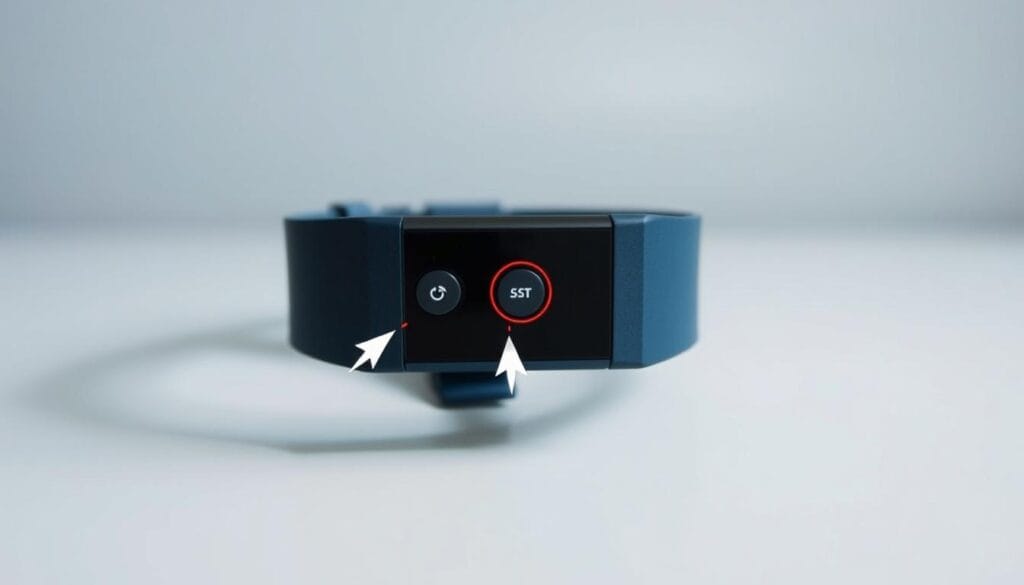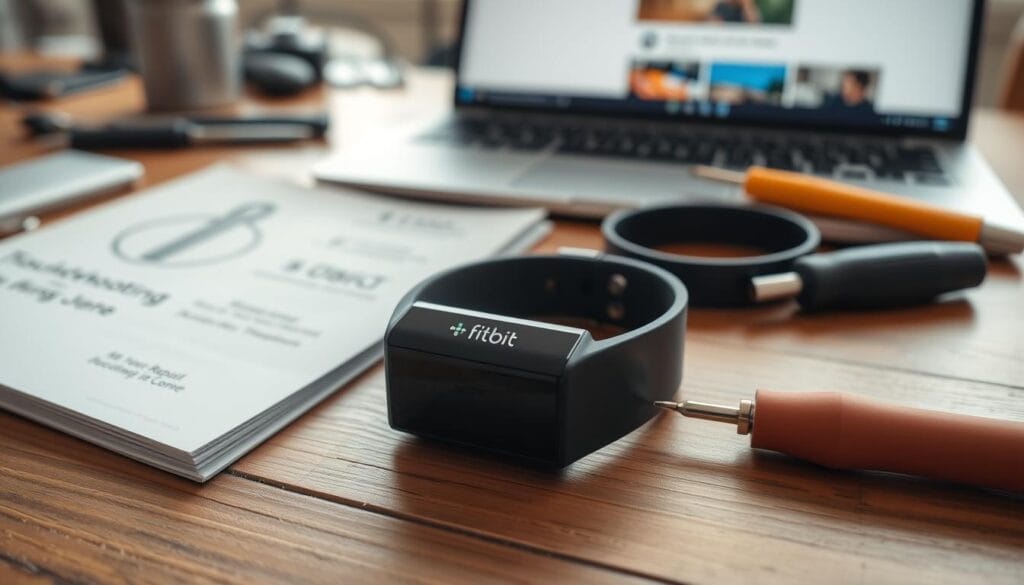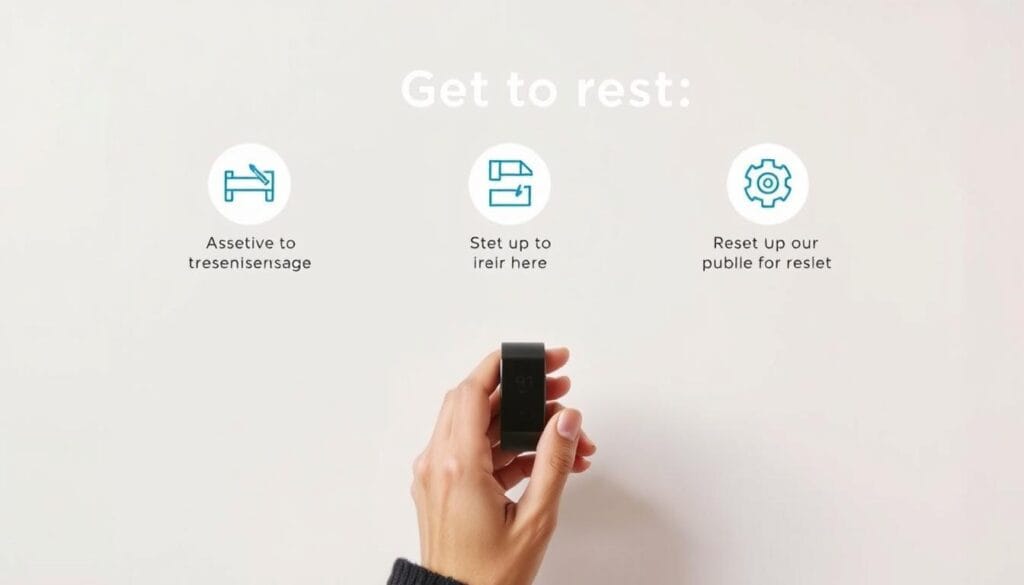Table of Contents
I’ve been using my Fitbit for a while now. Sometimes, it needs a reset to work right again. If you’re having trouble with your Fitbit, don’t worry. Resetting it is easy, and I’m here to show you how.
We’ll look at soft and hard resets. I’ll give you step-by-step guides for each. This way, you can fix any reset problems easily.

Introduction to Fitbit Reset
Resetting your Fitbit can solve many issues, like syncing problems or a frozen screen. By following the right steps, you can make your Fitbit work like new again. We’ll talk about the different resets and how to do them right.
Key Takeaways
- Resetting your Fitbit can solve many problems, like syncing issues or a frozen screen.
- There are different types of resets, including soft and hard resets.
- Following the correct fitbit reset steps is key to avoid problems.
- Resetting your Fitbit can make it work better and last longer.
- It’s important to back up your data before resetting your Fitbit.
- Knowing how to fix fitbit reset issues can save you time and trouble.
Why You Might Need to Reset Your Fitbit
As a Fitbit user, you might face issues where your device doesn’t work right. This can be really frustrating, especially if you count on it for tracking your daily activities and health. In such cases, resetting your Fitbit could be the answer. You can follow the factory reset fitbit instructions given by the maker.
There are many reasons you might need to reset your Fitbit. Common problems include a frozen screen or tracking that’s off. If you’re having these issues with your reset fitbit charge or reset fitbit versa, a reset might fix it. Other signs include a device that won’t start or one that’s not syncing with the Fitbit app.
Common Performance Issues
- Inaccurate step tracking
- Frozen or unresponsive screen
- Failed syncing with the Fitbit app
Signs Your Fitbit Needs a Reset
If you see any of these signs, it’s time to reset your Fitbit:
- Device won’t turn on
- Device is not responding to button presses
- Device is not tracking activities accurately
Benefits of Regular Resets
Resetting your Fitbit regularly can improve its performance and battery life. By following the factory reset fitbit instructions, you can make sure your device works well and lasts longer.
Different Types of Fitbit Resets Explained
There are two main types of resets for your Fitbit: master reset Fitbit and soft reset Fitbit. A master reset Fitbit takes your device back to its original settings, wiping out all your data and settings. This reset is best when you want to start over or sell your device. A soft reset Fitbit, on the other hand, just restarts your device without losing any data. It’s great for fixing small problems or glitches.
Here are some key differences between the two types of resets:
- Master reset Fitbit: restores device to factory settings, erases all data and settings
- Soft reset Fitbit: restarts device without deleting data, useful for minor issues or glitches
Choosing the right reset is crucial. If you’re facing big problems or want a clean start, go for a master reset Fitbit. But, if you’re dealing with small issues, a soft reset Fitbit is the way to go.
In summary, knowing about Fitbit resets helps you fix problems or keep your device in top shape. By picking the right reset, your Fitbit will work better and longer.
Essential Steps Before You Reset Your Fitbit
Before you reset your Fitbit, take a few important steps. This ensures a smooth reset and keeps your data safe. Start by backing up your data. You can sync your device with the Fitbit app to do this.
Next, check the battery level of your Fitbit. Make sure it has enough power for the reset. Open the Fitbit app to check the battery level. If it’s low, charge it first.
Syncing Your Device
Syncing your device is key in the reset process. It keeps your data up to date and backed up. Here’s how to sync your device:
- Open the Fitbit app on your phone or tablet
- Tap on the account icon in the top right corner
- Select your device from the list of available devices
- Wait for the sync to complete
By following these steps, you can reset your Fitbit confidently. Your data will be safe, and your device will be ready. These steps are essential for any Fitbit model, including the Fitbit Inspire.
How to Reset Fitbit: The Complete Guide
To reset your Fitbit, you’ll need to follow a series of steps. First, it’s essential to understand the different types of resets available. There’s a master reset and a soft reset. The master reset will erase all data on your device, while the soft reset will simply restart it.
When you need to troubleshoot Fitbit reset issues, it’s crucial to identify the problem. Some common issues include a frozen screen or a device that won’t sync. To resolve these problems, you can try restarting your device or checking for software updates.
Here are the steps to follow for a how to reset Fitbit device:
- Go to the Settings app on your Fitbit device
- Scroll down and select “About”
- Tap on “Reset” or “Factory Reset”
- Confirm that you want to reset your device
It’s also important to know how to troubleshoot Fitbit reset issues that may arise during the process. If you encounter any problems, you can try restarting your device or contacting Fitbit support for assistance.
In summary, resetting your Fitbit device is a relatively simple process. By following the steps outlined above and understanding how to reset fitbit and troubleshoot fitbit reset issues, you can get your device up and running smoothly in no time.
| Reset Type | Description |
|---|---|
| Master Reset | Erases all data on the device |
| Soft Reset | Restarts the device without erasing data |
Model-Specific Reset Instructions
Resetting your Fitbit depends on the model you have. It’s key to know the right steps for your device. We’ll cover how to reset Fitbit Charge, Versa, and Inspire models.
To reset your Fitbit Charge, follow a few steps to get it back to factory settings. This is called a reset fitbit charge. If you have a Fitbit Versa, you’ll need to do a reset fitbit versa. For Fitbit Inspire users, a hard reset fitbit inspire might fix your issues.
Here are the reset steps for each model:
- Fitbit Charge: Press and hold the button for 10 seconds, then release and press again for 10 seconds.
- Fitbit Versa: Open the Settings app, go to “About,” and choose “Factory Reset” for the reset fitbit versa.
- Fitbit Inspire: Hold the button for 15 seconds, then release and wait for it to restart. This starts the hard reset fitbit inspire.
Always back up your data before resetting, as it will erase everything. By following these steps, you can reset your Fitbit and make it work like new.
Troubleshooting Common Reset Problems
Resetting your Fitbit can sometimes go wrong. You might face issues like failed resets, lost data, or syncing problems. To troubleshoot fitbit reset issues, finding the cause is key. Then, follow the right steps to fix it.
Here are some steps to help you:
- Make sure your internet is stable and connected
- Double-check you’re using the right factory reset fitbit instructions for your model
- Try restarting your Fitbit and reset it again
If problems keep happening, reach out to Fitbit support. These steps should help you fix common reset issues and get your Fitbit working right.
Always use the correct troubleshoot fitbit reset steps to avoid more problems. If you’re not sure, check the Fitbit website or contact support for help.

What Happens After Your Fitbit Reset
After you reset your Fitbit, you might wonder what happens next. It’s important to know how to restore your settings and connect it to your phone. First, you’ll need to set up your Fitbit again by following the on-screen instructions. This includes choosing your language, pairing it with your phone, and logging into your Fitbit account.
After setting up your Fitbit, you can connect it to your phone. Open the Fitbit app on your phone and go to “Account” or “Settings.” Then, pick “Set up a new device” and follow the instructions. Remember, you might need to reset your Fitbit a few times if you run into problems.
- Restart your phone and Fitbit device to ensure they are both functioning properly.
- Check that your phone’s Bluetooth is enabled and that your Fitbit is in range.
- Verify that you are using the correct Fitbit app and account credentials.
By following these steps, you can quickly get back to tracking your fitness goals. Enjoy the benefits of your Fitbit device again.
When to Perform a Factory Reset
As a Fitbit user, you might need to reset your device to its original settings. This can seem scary if you’re not sure when to do it. We’ll talk about when a factory reset is needed and give you a checklist to make it easier.
A factory reset fitbit instructions are for when your device has ongoing problems. This includes issues like a frozen screen, failed updates, or data corruption. Always back up your data before resetting to keep your important info safe.
Pre-Factory Reset Checklist
- Back up your Fitbit data to ensure that your progress and history are saved
- Sync your device with your phone or computer to transfer any unsaved data
- Remove any connected devices or accessories to prevent interference
After you’ve done the pre-reset checklist, you can start the master reset fitbit. This will reset your device to its original state, wiping out all data and changes. Remember, a factory reset erases everything, so backing up is key.

After a factory reset, you can set up your device again and connect it to your phone or computer. Keep in mind that you can’t recover much data after a reset. So, it’s important to back up your data often to avoid losing it.
Maintaining Your Fitbit After Reset
To keep your Fitbit working well after a reset, follow some easy steps. Learning how to reset Fitbit is just the start. After resetting, make sure your device is updated and connected to the Fitbit app. This ensures you can track your progress and get notifications.
Here are some key steps to keep your Fitbit in top shape:
- Regular software updates: These updates often include bug fixes and new features that can improve the performance of your device.
- Syncing your device with the Fitbit app: This will help you track your progress and receive notifications.
- Performing regular backups: This will ensure that your data is safe in case you need to reset your device again.
By following these fitbit reset steps and keeping your device in check, it will continue to work well. Always update and sync your device to get the best from your Fitbit.
It’s also smart to learn about the Fitbit app and its features. This will help you use your device better and track your progress easily. With regular care and maintenance, you’ll enjoy a smooth and effective fitness tracking experience with your Fitbit.
Tips to Avoid Future Reset Needs
To keep your Fitbit working well, follow some simple steps. Regular updates and backups are key. They help your device run smoothly. This way, you can troubleshoot fitbit reset problems before they get worse.
Here are some daily habits to help:
- Sync your device often to keep data current
- Watch your battery level to prevent sudden shutdowns
- Stay away from extreme temperatures and water
By doing these things, you’ll need to reset your Fitbit less often. Remember, regular care can spot issues early. This makes fixing troubleshoot fitbit reset problems easier and faster.
Also, don’t let your device get too full. Too many apps or data can slow it down. By avoiding this, you’ll have a better experience with your Fitbit.
Conclusion
We’ve gone over how to reset a Fitbit device. Now, let’s summarize the main points. By following the Fitbit reset steps in this guide, you can fix performance issues. You can also restore your device to its original settings.
Remember, regular resets keep your Fitbit working well. This ensures you get the most out of it. It’s a great way to keep your fitness tracker in top shape.
If you run into problems during the reset, Fitbit’s customer support is here to help. They can guide you through any issues. With a bit of patience and the right steps, your Fitbit will be good as new.
This guide should give you the confidence to reset your Fitbit easily. Keep exploring and stay active. Don’t forget to share your Fitbit journey with us. Happy resetting!
FAQ
How do I reset my Fitbit?
To reset your Fitbit, follow these steps: 1. Find the reset button on your device. 2. Press and hold it for a few seconds until the Fitbit logo shows up. 3. Wait for it to restart, and your Fitbit will be back to normal.
What is the difference between a soft reset and a hard reset?
A soft reset is just a restart. It fixes small problems. A hard reset, or factory reset, resets your Fitbit to its original state. It erases all your personal data.
How do I know if I need to reset my Fitbit?
You might need to reset your Fitbit if: – It won’t sync with the app – It’s not tracking your activity right – It freezes or doesn’t respond – It won’t turn on or hold a charge
How do I reset my Fitbit Charge?
To reset a Fitbit Charge, do this: 1. Find the small button on the back. 2. Press and hold it for 5-10 seconds until the Fitbit logo shows. 3. Let go and wait for it to restart.
How do I reset my Fitbit Versa?
To reset a Fitbit Versa, do this: 1. Press and hold the back and bottom buttons together for 10-12 seconds. 2. Release them when you see the Fitbit logo and it starts to restart.
How do I reset my Fitbit Inspire?
To reset a Fitbit Inspire, do this: 1. Plug it into the charger and turn it on. 2. Press and hold the button for 10-12 seconds. 3. Release it when you see the Fitbit logo and it starts to restart.
You can read more how-to guides by clicking here.
Or you can check out our apps on the Play Store:

